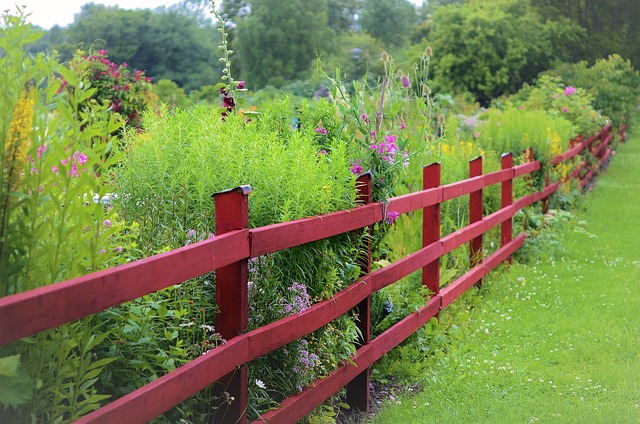Fences not only define your outdoor space but also play a crucial role in enhancing curb appeal. This article guides you through the art of fence staining and sealing, essential maintenance practices for wooden fences. We’ll delve into understanding the benefits and various types of stains, preparing your fence for optimal results, and step-by-step instructions for a flawless finish. Additionally, we explore the critical role of sealing, helping you choose the right sealant and ensuring long-lasting protection for your wooden fence.
- Understanding Fence Staining: Benefits and Types
- Preparing Your Wooden Fence for Staining
- Step-by-Step Guide to Perfect Staining
- The Role of Sealing in Fence Maintenance
- Choosing the Right Sealant and Application Tips
Understanding Fence Staining: Benefits and Types
Fence staining is more than just adding color; it’s a protective layer for your wooden fence. By sealing in the dye, stains protect wood from the elements, preventing rot and decay caused by sunlight, moisture, and extreme temperatures. Staining also enhances the visual appeal of your fence, offering a variety of colors and finishes to suit any style or preference.
There are two main types of fence staining: semi-transparent and solid. Semi-transparent stains allow some light penetration, preserving the wood’s natural look while still providing protection. Solid stains, on the other hand, create a more dramatic effect by blocking light entirely, resulting in rich, vibrant colors that can last up to several years with proper maintenance. Both types offer benefits, so the choice depends on your desired aesthetic and the level of protection needed for your fence.
Preparing Your Wooden Fence for Staining
Before applying any stain or sealant, it’s crucial to prepare your wooden fence thoroughly. Start by cleaning the fence to remove any dirt, dust, or debris that might hinder the staining process. Use a pressure washer or a soft-bristled brush and mild detergent to ensure the surface is clean and free from oils or previous sealants.
Next, sand the wood gently to create a rough texture. This step helps the stain penetrate deeper into the wood fibers, enhancing the color’s durability. After sanding, wipe down the fence again to eliminate any loose particles, and allow it to dry completely. Proper preparation guarantees that your fence not only looks its best but also retains the stain and sealant for an extended period.
Step-by-Step Guide to Perfect Staining
To achieve a flawless fence stain, follow these straightforward steps:
1. Prepare Your Fence: Begin by thoroughly cleaning your wooden fence to remove any dirt, dust, or existing stains. Sanding the surface slightly can also help create a smoother finish and better adhesion for the stain. Patch any holes or cracks using wood putty and allow it to dry completely.
2. Choose Your Stain: Select a high-quality exterior wood stain that suits your desired color and finish. Read the manufacturer’s instructions carefully, as different stains may have specific application guidelines and drying times. Test a small, hidden area first to ensure you like the color and that it’s evenly absorbed by the wood.
The Role of Sealing in Fence Maintenance
Fence staining and sealing go hand in hand when it comes to maintaining wooden fences. While staining enhances the aesthetic appeal, sealing plays a crucial role in protecting the wood from various environmental factors. A good sealant forms a protective barrier, shielding the fence from water damage, UV rays, and extreme temperatures. It also helps to prevent rot, mold, and mildew growth, which can weaken the structural integrity of the wooden panels over time.
Regular sealing is essential for long-lasting fence maintenance. It fills in any gaps or cracks, ensuring that no moisture seeps in and causes damage. Additionally, a fresh coat of sealant refreshes the overall look of the fence, bringing back its natural color and grain. By investing in quality sealants and making it a routine part of your fence care regimen, you can ensure your wooden fence remains vibrant, durable, and looking its best for years to come.
Choosing the Right Sealant and Application Tips
When choosing a sealant for your wooden fence, consider its purpose – protection from elements or enhanced aesthetics. Water-based sealants offer a more eco-friendly option with easier application and faster drying time, ideal for those prioritizing safety and convenience. On the other hand, oil-based sealants provide deeper penetration and longer durability, making them suitable for harsher environments or if you want a longer-lasting, high-gloss finish.
Application tips include preparing the fence surface by cleaning and sanding to ensure even coverage. Apply the sealant in thin, even coats, allowing each coat to dry completely before adding another. Start from the top and work your way down to avoid streaking, and don’t forget to protect your clothes and skin with appropriate gear. Regular reapplication is key to maintaining the fence’s health and appearance, so choose a schedule that suits your needs based on local weather conditions and product recommendations.
